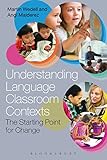Understanding language classroom contexts : the starting point for change / Martin Wedell and Angi Malderez.
Material type: TextPublisher: New York : Bloomsbury Academic, 2013Description: 1 online resource (248 pages)Content type:
TextPublisher: New York : Bloomsbury Academic, 2013Description: 1 online resource (248 pages)Content type: - text
- computer
- online resource
- 9781441198372
- 1441198377
- 9781299184558
- 1299184553
- 9781441160591
- 1441160590
- 9781441102454
- 1441102450
- 9781472553287
- 1472553284
- 418/.007 23
- P51 .W346 2013eb
| Item type | Home library | Collection | Call number | Materials specified | Status | Date due | Barcode | |
|---|---|---|---|---|---|---|---|---|
 Electronic-Books
Electronic-Books
|
OPJGU Sonepat- Campus | E-Books EBSCO | Available |
Includes bibliographical references and index.
Print version record.
1. Components of contexts -- 2. Exploring culture -- 3. Language and languages in education -- 4. From cultures to methods -- 5. From methods to approaches -- 6. Teachers and learners: As part of and creators of their context -- 7. Teachers and learners: As 'products' of their context -- 8. Schools and classrooms: Physical and cultural contexts -- 9. Planning and implementing classroom change -- 10. Conclusions: On understanding language classroom contexts and the process of change.
Introduction -- 1. Who we are and why we have written this book -- 2. Who might find this book useful? -- 3. What is in the book? -- 4. Chapter outlines -- 5. Ways to use the book -- 1. Components of contexts -- Introduction -- 1. Description of a context -- 2. Developing a framework for understanding context -- 3. The context of place -- 4. Time -- 5. People -- 6. Summary and task -- 2. Exploring culture -- Introduction -- 1. Exploring CULTURE -- 2. The historical perspective -- 3. Seeing the relevance of 'Culture' to our purpose -- 4. Classroom cultures -- 5. Summary and task -- 3. Language and languages in education -- Introduction -- 1. Language and learning -- 1.2 The Zone of Proximal Development and scaffolding -- 2. Languages in contexts -- 3. The global importance of English -- 4. The Importance of English in and to your country -- 5. Where English is taught or used in the education system -- 6. Summary and task -- 4. From cultures to methods -- Introduction -- 1. Why do methods change? -- 2. A brief history of methods: The Grammar Translation Method (GTM) -- 3. A brief history of methods: The Audio-Lingual method (ALM) -- 4. A brief history of methods: Humanistic methods -- 5. Summary and task -- 5. From methods to approaches -- Introduction -- 1. Communicative approaches -- 2. Changing perceptions of language -- 3. Language syllabuses and language exams -- 4. Communicative approaches in different contexts -- 5. Conclusion -- 6. Summary and task -- 6. Teachers and learners: As part of and creators of their context -- Introduction -- 1. Teachers and learners and contexts -- 2. On people creating contexts of and for learning -- 3. What people feel -- 4. Summary and task -- 7. Teachers and learners: As 'products' of their context -- Introduction -- 1. People as products of contexts: Factors distinguishing individual teachers -- 2. People as products of contexts: Factors distinguishing individual learners -- 3. Good language learner -- 4. Teachers as learners and learners as teachers -- 5. Summary and task -- 8. Schools and classrooms: Physical and cultural contexts -- Introduction -- 1. Visible features of the classroom or institutional context -- 2. Some reasons why 'large' classes exist -- 3. School/institutional culture -- 4. Cultures of organisations -- 5. School leadership -- 6. Schein's levels of organisational culture -- 7. Summary and task -- 9. Planning and implementing classroom change -- Introduction -- 1. Teacher-initiated classroom changes -- 2. Externally initiated classroom changes -- 3. A parallel learning model -- 4. Summary and task -- 10. Conclusions: On understanding language classroom contexts and the process of change -- Introduction -- 1. Summarising the book -- 2. And finally.
"Arguably the whole point of education is to effect change in what people know and are able to do. Globalization has contributed to a common perception worldwide of the need to introduce changes to the teaching and learning of languages. The success of many attempts to do so has been limited by insufficient consideration of implementation contexts. Understanding Language Classroom Contexts explores and illustrates how what happens in any (language) classroom is influenced by (and can be an influence on) the contexts in which it is situated. A clear understanding of these influences is thus the starting point for planning effective change. The book considers many visible and invisible features of the multiple layers of any context, and provides a framework for understanding the types of factors that may influence whether changes (planned by a teacher or externally initiated) are likely to be successful. The book will help teachers (and educational managers or change planners outside the classroom) to understand why their classrooms are as they are and so to make informed decisions about what can or cannot (or not easily) be changed, and suggests how any changes might be appropriately managed"--EBL
English.
eBooks on EBSCOhost EBSCO eBook Subscription Academic Collection - Worldwide
There are no comments on this title.

